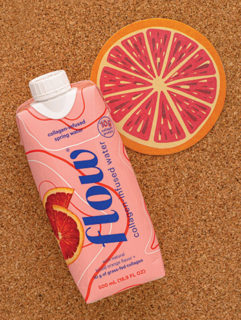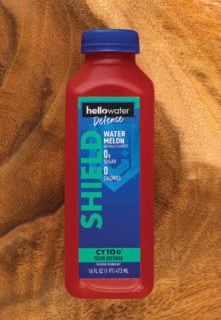The Deep End: Upstarts and Legacy Brands Battle in Bottled Water
Sometime in the last decade or so, while we were all worried about staying hydrated, American consumers made an important decision: why shouldn’t the bottled water products that they spend over $21 billion on annually reflect the same kind of dynamic branding, packaging, flavors and functional benefits that they expect from other major beverage categories?
If you need an answer to that, spend some time in the water section at any modern retailer: packaged in everything from 16 oz. tallboy cans to reusable aluminum bottles to rPET, glass, and various paper formats, the category features an increasingly diverse set of sub-spaces, encompassing products ranging from smartwater’s ashwagandha-enhanced Tranquility to eco-friendly Richard’s Rainwater, to those — now seemingly quaint — brands offering up processed, unflavored alkaline water. Without even getting into the complexities of their respective impact on environmental issues like single-use packaging waste and sustainable water sourcing, there’s a lot to take in, and a lot of voices vying to be heard. Hey, you asked for it.
As the water market chessboard continues to be rearranged, forcing old players to evolve and leave behind space for younger ones to move into, the question isn’t so much if the category will keep growing as it is who will shape its future, and how.
Riding the Waves
Regarding investment, companies in the business of selling unflavored packaged water aren’t the hottest of targets. As a commodity item with a handful of dominant brand names, not to mention a vast private label business, notable deals in the space have mostly centered around situational opportunities with either well-connected startups (ZenWTR, Hint, Flow) or big-ticket transactions among the large conglomerates, as when Nestlé shed its Nestlé Waters North America (NWNA) portfolio and acquired Essentia last spring.
The exception to that rule is California-based canned water maker Liquid Death; while its ravenous appetite for viral marketing projects has stolen the headlines over the past year, the brand’s biggest validation may have come in January with the closing of a $75 million Series C round led by startup studio Science Inc., bringing its total financing war chest of $125 million. The combination of its counter-cultural branding and better-for-the-planet credentials has won Liquid Death a fervent following among younger consumers, but the raw figures — $45 million in 2021 top-line revenue; 29,000 retail locations nationwide, including Whole Foods, 7-Eleven and Target; roughly $10 million in earned media, according to the brand — are what has attracted experienced CPG investors like Mark Rampolla and Powerplant Partners. Speaking to BevNET in January,Rampolla described the brand as the “next Red Bull,” a comparison echoed by managing partner Dan Gluck; as a testament to its IP’s current popularity, Liquid Death’s apparel sales passed $3 million last year (its branded clothing is also sold in Urban Outfitters stores). With a new line of flavored, agave-sweetened sparkling waters currently rolling out to conventional and c-stores, arriving at the heels of its well-received debut Super Bowl TV spot, the brand looks set to continue its rapid ascent — even if it took backlash from some fans for its Murder Head Death Club NFT collection in March.
Elsewhere, premium water brand Flow Beverage Corp. has experienced mixed fortunes over the past 12 months, continuing to put up impressive top-line growth numbers while recording significant losses along the way. The Canadian publicly traded company — marketers of a pure U.S.-sourced spring water, alongside flavored and collagen-infused SKUs that are sold in over 24,600 locations — reported consolidated net revenue increased by 86% during FY2021 to $42.7 million, fueled by a 47% rise in retail and e-commerce channels. After reporting in September that YTD adjusted EBITDA losses were down 12% to $19.3 million, Flow reported a loss of $27 million for the full fiscal year 2021, down just slightly from $27.3 million in FY2020. The company is working to improve its position, though, targeting a 45%-50% reduction in overall EBITDA losses by the end of FY2022, and it hasn’t slowed plans to continue scaling the portfolio with innovations like its vitamin-infused flavored water line or securing marketing new partnerships with the New York Marathon and the Montreal Canadiens of the NHL.
For BlueTriton Brands, the company formed to complete the $4.3 billion purchase of NWNA’s set of domestic commodity brands in February 2021, acquisitions and growth are still top of mind. Last November, the company signed a deal to bring Saratoga Spring Water Company (SSWC) into the fold for an undisclosed fee, in a move that BlueTriton leadership described as an opportunity “expand its brand offerings and access a national, upscale beverage market” and while “maintaining production of the premium products SSWC is known for,” according to a press release.
One of the original bottled spring waters in the U.S., New York-based SSWC will likely play a different role in BlueTriton’s mix relative to the six regional spring water brands — Poland Spring, Ozarka, Ice Mountain, Zephyrhills, Arrowhead and Deer Park — it picked up in the Nestlé deal, along with 27 production facilities in North America, plus the Pure Life trademark and the ReadyRefresh delivery platform. While those products play in the category’s lower price range, SSWC, which markets premium water in glass bottles mainly to hospitality accounts, helps address one of the gaps in its parent company’s evolving portfolio: Nestlé kept its premium imported sparkling and still brands S. Pellegrino, Acqua Panna and Perrier in the NWNA sale, and previous attempts to generate traction for carbonated or premium-positioned SKUs of Poland Spring have seen mixed results.
Behind the scenes, BlueTriton has also quietly assembled an experienced team to run operations. Javier Idrovo, formerly of Hain Celestial, arrived as the company’s new chief financial officer in February, while CPG veteran Scott McIntyre was hired as EVP and GM for its Canadian division the following month.
According to NielsenIQ data, retail dollar sales for BlueTriton’s portfolio rose 13.5% to over $4.6 billion in the 52-week period ending March 12. During that time, the company saw an average price increase of around 5.2%, coming in under the industry average of 8.2%, while volume was up 8.4%.
Function Flows Forward
According to data available on Statista, the functional bottled water market is expected to surpass $5 billion by 2022. And though sparkling water is the preferred canvas for many water brands to launch their functional products, still bottled water has seen its share of innovation in that department.
Produced via patented “Advanced Cellular Hydration Technology” that adds essential minerals and charging the water with electrons to improve absorption, Florida-based Jove (pronounced Joh-Vee) has made some inroads in the South and Northeast, where it is collectively sold across over 1,200 stores including Publix and Giant Foods. Elsewhere, a group of former Mountain Valley Spring Company (MVSC) veterans, including former CEO Breck Speed, are helping bring Splendor Water, an Ecuadorian import brand marketed as the only bottled water in the world to contain naturally occurring colloidal gold and silver, to the U.S. market. The product is available in 100% rPET blue plastic bottles in four sizes — 1.5 liter, 1 liter, 750 milliliter, and 500 milliliter — and in 350ml and 750ml glass bottles. The brand is taking a tiered approach to its U.S. retail rollout, starting with direct-to-consumer sales before moving to partner with select lower-scale retailers in the North Carolina area later this year.
In explaining the benefits of colloidal silver and gold, Splendor highlights the story of its original founder, scientist Guillermo Sotomayor, who discovered the source in the 1980s while excavating near the volcano in an area called La Mana, known as one of the world’s “energy centers” due to its elevation and proximity to the equator. That stands in contrast to the more science-driven approach from brands like Nirvana Water Sciences. Backed by an experienced team that includes many former VOSS sales reps, has leaned into a specific functional ingredient (water-soluble HMB, for which it retains the exclusive global rights) to build its message, along with enlisting NBA star and investor Kyle Lowry for marketing support. During Natural Products Expo West in March, the company introduced its newest line extension, Nirvana HMB + Vitamin D3, with the latter being a particularly hot ingredient for functional water at the moment following the success Shine Water has seen in building around it.
That increased visibility for the category has also benefited established brands like hydrogen-infused water HFactor or Hellowater, which offers SKUs with fiber as well as CYTO PLUS, a patented ingredient that supports immune system defense and boosts toxin elimination. Both companies have rolled out new flavors and brand redesigns this spring. At Expo West, HFactor introduced an 8-count multipack option and a revamped look for its 11 oz. cans and 20 oz. pouches, plus a new flavor called Blackbeary. Meanwhile, Chicago-based Hellowater is also showcasing a brand makeover, while digging deep into its partnership with NASCAR and preparing to launch powdered mix versions of its drinks in Q2 2022. There’s also publicly traded hydrogen water startup NXT LVL, which has grabbed attention thanks to its affiliations with boxing legend Manny Pacquiao and UFC champion Anthony Pettis, and which was recently accepted into L.A. Libations’ SoCal Incubation Program (SIP) to expand along the West Coast.


Receive your free magazine!
Join thousands of other food and beverage professionals who utilize BevNET Magazine to stay up-to-date on current trends and news within the food and beverage world.
Receive your free copy of the magazine 6x per year in digital or print and utilize insights on consumer behavior, brand growth, category volume, and trend forecasting.
Subscribe



